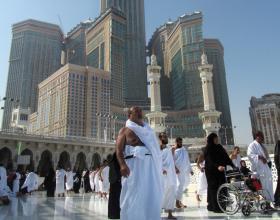  
|
|
Mecca: The Sacred City
by Ziauddin Sardar http://www.islamicpluralism.org/2418/mecca-the-sacred-city Since Islam emerged more than 14 centuries ago, Mecca, near the western coast of the Arabian peninsula, has drawn the interest of the world. For Muslim believers, the city and its sacred mosque—which encompasses a high, cubical structure, the Kaaba—are the focus of spiritual devotion as the qibla, or direction of prayer, and a destination for pilgrimages. For non-Muslims, Mecca has long been enigmatic, as it has been closed to them since early in Islamic history. Ziauddin Sardar, a British Muslim of Pakistani background, has written an extensive history of Mecca. His panorama is somewhat limited, with attention focused on the great mosque and the Kaaba. Sardar's account of Mecca's origins is based on conventional religious and historical sources, as is his treatment of Muhammad, who would make the city famous. The foundation of the Kaaba has been credited, in Islamic tradition, to Adam, as well as to Abraham and his first son Ishmael (Ismail), progenitor of the Arabs and, through descent from Ismail to Muhammad, of the Muslims. Sardar details how the original association with Abraham, the common originator of Jewish, Christian, and Muslim monotheism, was replaced with a vision of Mecca as a heavenly city in which Adam and Eve dwelt after their expulsion from paradise. Before the coming of Muhammad and Islam, however, faith in a single omnipotent God (Allah) had been forgotten in Mecca, and it and the Kaaba drew wayfarers worshipping numerous idols. The commerce in pagan pilgrims and festivals was profitable for the Meccans, and in the established, theological narrative, Muhammad (who could neither read nor write) received a message from the Creator through an angel while meditating in a cave on Jabal al-Nur, the "hill of light," overlooking Mecca. He was to warn the Meccans, his neighbors and kin, against their polytheist practices. Muhammad's teaching was not met with enthusiasm, even among his own tribe, the Quraysh, who claimed descent from Abraham and Ismail. Stories of Muhammad's travails in Mecca, the harassment of his few early followers, his move to Yathrib—a town that became known as Medina ("the city") after he established himself there—and the ensuing battles between the Meccans and Medinans are essential to Islamic religiosity. Muhammad and the Medinans conquered Mecca and removed the idols from the precincts of the Kaaba. But the renewal of monotheism in the holy city of the Arabs did not lead to peace: Long chronicles recounted by Sardar involve conflicts among familes, tribes, and other factions in the city, as well as with sectarian rivals from elsewhere, broken by rare periods of tranquility. In addition, successive rulers of Mecca reconstructed the Kaaba and expanded and decorated the great mosque, sometimes after natural disasters that undermined the structures. Mecca retained its allure as a destination for religious journeys, and, as Sardar portrays, it had a rich cultural environment in which the diverse identities of the hajj pilgrims were crucial. Religious jurists and spiritual Sufis also flocked to Mecca. In a well-known episode involving Islamic metaphysics, the Spanish Muslim Ibn Arabi (1165-1240) went to Mecca for the hajj, stayed in the city for some time, and wrote several of the masterpieces that have contributed to Ibn Arabi's reputation as "al-Sheikh al-Akbar," the supreme teacher. These works, inspired by the environment of the city, include Meccan Revelations, in which Ibn Arabi constructs an elaborate interpretation for the exalted nature of the city, and a collection of odes entitled The Interpreter of Desires. The latter text is extravagant in its praise of an unnamed female, the daughter of Ibn Arabi's Meccan host, and is a Sufi classic. Its impassioned verses were taken up by the Meccan youth and recited to musical accompaniment. Ibn Arabi was compelled to write a line-by-line commentary in which he denied the physical and sensual content of his poetry and ascribed the love it professed to adoration of the divine. Sardar's account of Meccan history shifts distinctly when, at the end of the 18th century, the agitation of Muhammad Ibn Abd al-Wahhab (for whom the Wahhabi sect is named) erupted from Najd, in the desolate interior of Arabia. Like fanatics before them and their imitators today, the Wahhabis condemned as un-Islamic many customs that had become part of the religion. The Wahhabis denounced the Sufis and Shiites, declaring that prayer at shrines as practiced by nearly all Muslims, but especially by the mystics, was revived idolatry and that it, along with music, dancing, and smoking, had contaminated Mecca. Wahhabis attacked Baghdad, then pillaged Karbala, the Shia shrine-city in Iraq where Hussein Ibn Ali, grandson of Muhammad, is buried. The Wahhabis had forged their marriage alliance with the house of al-Saud, a hitherto-unknown clan; religious duties were to be assigned to the descendants of Ibn Abd al-Wahhab and political rule to those of al-Saud. The two families have wed each other's heirs to the present, with the kingdom of Saudi Arabia, established in the 20th century, recognizing Wahhabism as the privileged source of doctrinal legitimacy within its borders. Sardar is an appropriately severe critic of Wahhabi violence and its consequences for Mecca. The Wahhabis prohibit preservation of historical buildings (along with shrines) out of fear that they may become "idols" as objects of worship. This has led to an absence of urban planning and the transformation of Mecca, symbolized most famously by the Mecca Royal Clock Tower, a Stalinesque pile that looms over the great mosque and the Kaaba. At the same time, the Saudis have neglected the city's water and sanitation needs; yet the clock tower is surrounded by expensive hotels and shopping malls. In addition, the late King Fahd erected an inelegant, modernist royal palace next to the great mosque, and heedless expansion of the great mosque goes on.
Mecca, in Sardar's view, does not change. It profited from the worship of idols before Muhammad, and today it makes money from the sale of religious kitsch, much like any other pilgrimage site around the world. Sardar has delivered an impressive indictment of the metamorphosis of Mecca, which includes the destruction of old neighborhoods and has left it without the cultural, artistic, and architectural legacy that is visible in other major cities around the world. Much of his criticism repeats that of his mentor, the Saudi dissident architect Sami Angawi, and echoes admonitions by Irfan al-Alawi, who heads the Islamic Heritage Research Foundation and contributed on this topic in these pages ("Bulldozing Islam," October 6, 2006). Sardar, however, defines himself as a "post-modern" Muslim and tends to blame the West, and specifically the United States, for the desecration of Islam's most sacred precincts. Like others, he decries a Mecca that seems remodeled in the image of Disneyland or Las Vegas. But his bitterest comments equate today's Mecca with Houston, which Sardar sees as the epitome of a characterless metropolis rich from energy resources. This is unfair: Houston shelters the Menil Collection, one of the great museums of modern art, among other worthy institutions, and certainly provides adequate public services. But it seems that Sardar, a Muslim blinded by resentment of America, will never see Houston through the eyes of born Westerners—although, unlike non-Muslims who would like to visit Mecca, he is free to go there. Related Topics: African-American Muslims, Albanian Muslims, American Muslims, Balkan Muslims, Bektashi Sufis, Bosnian Muslims, British Muslims, Canadian Muslims, Central Asia, Chechnya, China, Dutch Muslims, European Muslims, French Muslims, German Muslims, Indonesia, Iran, Iraq, Irfan Al-Alawi, Kazakhstan, Kosovo, Kurdish Islam, Kyrgyzia, Macedonia, Malaysia, Montenegro, Pakistan, Russia, Saudi Arabia, Shiism, Sufism, Turkish Islam, Uighurs, Uzbekistan, Wahhabism, WahhabiWatch receive the latest by email: subscribe to the free center for islamic pluralism mailing list |
Related Items Latest Articles |
||||
|
© 2025 Center for Islamic Pluralism. home | articles | announcements | spoken | wahhabiwatch | about us | cip in the media | reports external articles | bookstore | mailing list | contact us | @twitter | iraqi daily al-sabah al-jadid |
|||||
